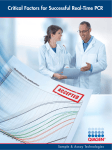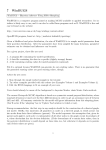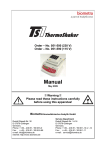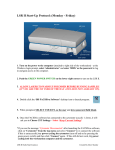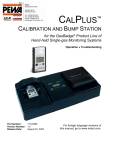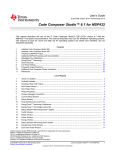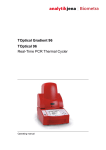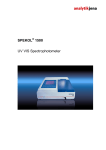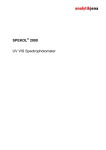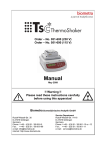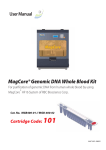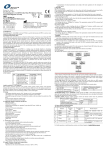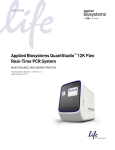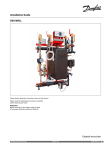Download qTOWER 2.0 /qTOWER 2.2 Real-Time PCR
Transcript
qTOWER 2.0 /qTOWER 2.2 Real-Time PCR Thermal Cycler Operating manual Service: Analytik Jena AG Customer Services Konrad-Zuse-Str. 1 07745 Jena Germany Phone: Email: Hotline: + 49 (0) 3641 / 77-7407 Fax: + 49 (0) 3641 / 77-7449 [email protected] General information about Analytik Jena AG on the internet: http://www.analytik-jena.de Copyrights and Trademarks Microsoft, Windows XP/VISTA/7, MS Excel are registered trademarks of Microsoft Corp. The identification with ® or TM is omitted in this manual. Documentation number: 10-3100-102-23 Edition – July 2012 Implementation of the Technical Documentation: Analytik Jena AG This publication describes the state of this product at the time of publishing. It need not necessarily agree with future versions of the product. Modifications reserved! © Copyright 2012 Analytik Jena AG Contents Table of Contents 1 2 Basics.................................................................................................... 3 1.1 Intended Use .................................................................................................. 3 1.2 Notes on the manual ...................................................................................... 4 1.3 Warranty and liability ...................................................................................... 4 Safety instructions ............................................................................... 5 2.1 Symbols and signal words used ..................................................................... 5 2.2 Safety markings at the qTOWER 2.0/2.2 ....................................................... 5 2.3 Technical condition ......................................................................................... 6 2.4 Requirements for the operating personnel ..................................................... 6 2.5 Safety instructions, transport and installation................................................. 7 2.6 Safety instructions - operation ........................................................................ 7 2.6.1 General ........................................................................................................... 7 2.6.2 Safety instructions - Protection against explosion and fire ............................ 8 2.6.3 Safety instructions - electrical equipment....................................................... 8 2.6.4 Handling of samples, auxiliary and operating materials ................................. 8 2.6.5 Safety instructions - service and repair .......................................................... 9 2.7 Behavior during emergencies ........................................................................ 9 2.8 Standards and directives .............................................................................. 10 3 Technical data .................................................................................... 11 4 Device description and principle of operation................................. 13 5 Commissioning .................................................................................. 15 5.1 Site requirements ......................................................................................... 15 5.2 Connections and controls at the qTOWER 2.0/2.2 ...................................... 16 5.3 Installation and commissioning .................................................................... 18 5.4 Switching the qTOWER 2.0/2.2 on and off .................................................. 19 6 Inserting samples / Starting the PCR run ......................................... 21 7 Maintenance and care ........................................................................ 22 8 7.1 Cleaning the housing.................................................................................... 22 7.2 Cleaning the sample block ........................................................................... 22 7.3 Cleaning the lens array ................................................................................ 23 7.4 Installing color modules ................................................................................ 23 7.5 Replacing the fuses ...................................................................................... 27 Transport and storage ....................................................................... 28 8.1 Transport ...................................................................................................... 28 8.2 Returns ......................................................................................................... 28 8.3 Moving the qTOWER 2.0/2.2 within the laboratory ...................................... 29 8.4 Storage ......................................................................................................... 29 9 Decontamination certificate .............................................................. 30 10 Disposal .............................................................................................. 32 qTOWER 2.0/2.2 Edition 07/2012 1 Figures Index of Figures Fig. 1 Fig. 2 Fig. 3 Fig. 4 Fig. 5 Fig. 6 Fig. 7 Fig. 8 Fig. 9 Fig. 10 2 Structure of the qTOWER 2.0/2.2 ........................................................................... 13 Schematic structure of the Epi fluorescence photometer in the qTOWER 2.0/2.2 14 qTOWER 2.0/2.2 front view .................................................................................... 16 qTOWER 2.0/2.2 opened ....................................................................................... 16 qTOWER 2.0/2.2 backplate .................................................................................... 17 Voltage selection switch at the bottom of the qTOWERs 2.0/2.2 ........................... 17 Connection and power supply cables for the qTOWER 2.0/2.2 ............................. 18 Schematic representation of the position of additional vessels in case of low sample numbers ..................................................................................................... 21 Position A1 on the sample block ............................................................................ 21 Fuse holder at the qTOWER 2.0/2.2 ...................................................................... 27 Edition 07/2012 qTOWER 2.0/2.2 Basics 1 Basics 1.1 Intended Use qTOWER 2.0/2.2 is a thermal cycler for amplifying DNA by way of the polymerase chain reaction (PCR) licensed for real-time PCR experiments. The license is limited to applications outside of vitro diagnostics (research use only). The integrated detector enables the measurement of the sample fluorescence in up to six spectral channels during the PCR, with the filters used in the color or FRET modules being exactly matched to the properties of the most frequently used fluorescence dyes, thereby permitting a sensitive and selective detection of fluorescent PCR products. Analytik Jena offers a number of color or FRET modules of which up to six can be installed simultaneously in the device. Replacement and retrofit of color or FRET modules can be easily accomplished. qTOWER 2.0/2.2 is an open platform for real-time PCR and supports both intercalating dyes as well as individual samples and kits of various manufacturers. qTOWER 2.0/2.2 can be used in different applications, such as expression analyses, genotyping and the detection of pathogens. qTOWER 2.0/2.2 is fully controlled from the PC using the program qPCRsoft. qPCRsoft provides the following functions Device control and monitoring User Management Context-sensitive help functions Design of real-time PCR experiments and their evaluation Storage of methods (templates) and measuring results (projects) Planning and evaluation of − Absolute quantifications − Relative quantifications − ΔΔCt analyses − DNA melting curves − Genotyping Results printout Results export to MS EXCEL or as CSV file Results export to extended programs for the analysis of real-time PCR data (e.g. qBASE, REST etc.) in preparation A detailed description of qPCRsoft is available in the software manual. qTOWER 2.0/2.2 Edition 07/2012 3 Basics 1.2 Notes on the manual qTOWER 2.0/2.2 is intended for operation by qualified specialist personnel observing this user manual. The user manual informs about the design and function of the unit and and provides personnel familiar with PCR technology with the necessary know-how for the safe handling of the equipment. The user manual also provides notes on the servicing and caring for the unit. Conventions Instructions for action which occur in chronological order are numbered and combined into action units and furnished with the corresponding results. Lists which are not in chronological order are shown as itemized lists, sub-listings as bullet points. Safety notes are indicated by pictographs and signal words. The type and source of the danger are stated together with notes on preventing the danger. The meaning of the pictographs and signal words used is explained in section "Symbols and signal words used" p. 5. The elements of the control and analysis program are indicated as follows: 1.3 Menu command, buttons, options etc. are indicated by small caps. Menu commands of a command sequence are separated by slashes ( / ), e.g. FILE / NEW. Buttons are marked with square brackets, e.g. [ADD]. Warranty and liability The warranty duration and liability comply with the legal requirements and the provisions in the general terms and conditions of Analytik Jena AG. Deviations from the intended use described in this user manual will result in limitations of warranty and liability in the event of damage. Warranty and liability claims for personal injury and property damage are excluded if they were caused by one or several of the following reasons: 4 use of the qTOWER 2.0/2.2 other than intended improper commissioning, operation and service of the device modifications of the equipment without prior consultation with Analytik Jena AG unauthorized intervention in the equipment operation of the device with faulty safety equipment or improperly fitted safety and protection equipment inadequate monitoring of the equipment components subject to wear use of other than original spare parts, wear parts or consumables improper repairs faults due to the non-observance of this user manual Edition 07/2012 qTOWER 2.0/2.2 Safety instructions 2 Safety instructions 2.1 Symbols and signal words used The user manual uses the following symbols and signal words to indicate hazards or instructions. The safety instructions are always placed before an action. WARNING Indicates a potentially hazardous situation. If it is not prevented death or most serious injuries (incapacitation) can result. CAUTION Indicates a potentially hazardous situation. If it is not prevented light or minor injuries and material damage can result. CAUTION! HOT SURFACE! Touching the hot surface can cause burns. WARNING! DANGER OF ELECTRIC SHOCK IF TOUCHED! IMPORTANT Indicates application hints and other especially useful information without any resulting hazardous or damaging situations. 2.2 Safety markings at the qTOWER 2.0/2.2 Safety symbols have been attached to the qTOWER 2.0/2.2 whose content must always be observed. Damaged or missing safety symbols can cause incorrect actions leading to personal injury or material damage! The safety symbols must not be removed! Damaged safety symbols must be replaced without delay! The following safety symbols have been attached to the analyzer and accessories: Warning against hot surface qTOWER 2.0/2.2 General warning sign Edition 07/2012 Before opening the device always disconnect the plug! 5 Safety instructions 2.3 Technical condition The qTOWER 2.0/2.2 corresponds in its design and construction to the current state of the art technology. Unauthorized modifications or changes, especially such that affect the safety of the staff and the environment, are generally not allowed. The following has to be observed: 2.4 Any manipulation of the safety equipment is prohibited! In case of an accident manipulations of the safety equipment will be interpreted as deliberate! The operator must only operate the device in a sound and operationally safe condition. The technical condition must always comply with the legal requirements and regulations. Prior to every use the device must be checked for damage and sound condition. Any changes in the device affecting its safety must be reported by the operating personnel to the operator without delay. Requirements for the operating personnel The qTOWER 2.0/2.2 must only be operated by qualified specialist personnel instructed in the use of the device. The instruction also includes imparting the contents of this user manual. In addition to the safety at work instructions in this user manual the generally applicable safety and accident prevention regulations of the respective country of operation must be observed and adhered to. The operator must ascertain the latest version of these regulations. The user manual must be accessible to the operating and service personnel at any time! The following has to be observed: 6 The device must only be commissioned, operated and serviced by trained personnel instructed in technical safety. The operation or servicing of the device by minors or individuals under the influence of alcohol, drugs or medication is not permitted. It must be ensured that only authorized personnel works at the device. The operating personnel must be familiar with the dangers arising from samples and excipients. The appropriate protective equipment must be used. Prior to pauses or at the end of the work appropriate skin cleaning and protection measures must be carried out. Eating, drinking and smoking at the installation location of the device are prohibited! Edition 07/2012 qTOWER 2.0/2.2 Safety instructions 2.5 Safety instructions, transport and installation The qTOWER 2.0/2.2 is can be installed by the customer service department of Analytik Jena AG or its authorized and trained specialist personnel. The following has to be observed: Only transport the device in its original packaging! Make sure that the device has been drained and no samples vessels are in the sample block. To prevent health damage the following must be observed when moving the device in the laboratory (lifting and carrying): − For reasons of safety 2 persons are required to transport the device and must position themselves on both sides of the equipment. − Since the device does not have handles, grip the device firmly with both hands at the lower end, lifting it simultaneously. − The guide values and statutory limits for lifting and carrying loads without auxiliary equipment must be observed and adhered to. 2.6 Safety instructions - operation 2.6.1 General The operator of the qTOWER 2.0/2.2 must make sure before each commissioning that the condition of the device including the safety equipment is sound. The following has to be observed: qTOWER 2.0/2.2 Free access to the power switch on the back of the enclosure has to be ensured during operation. The ventilation fittings at the rear of the device must be operational. Covered vents or ventilation slits etc. may cause the device to break down or may cause damage to it. The use of oil between the samples and the sample block is not necessary to achieve an improved heat exchange. However, if you still want to use oil, you should use mineral oil. Do not use silicone oil! The thermal block, the samples and the heated lid reach high temperatures. There is a risk of burns during contact. The rapid heating of the thermal block can cause liquids to boil explosively. Therefore, always wear safety glasses during operation! Prior to starting a program close the lid of the device! The samples may reach high temperatures. Do not touch hot sample vessels or plates and do not open them or boiling liquid might splash out! Ensure that the lid is safely closed before starting the program! Do not touch the heated lid! Only use plates and vessels suitable for high temperatures (up to 100°C), fitting well into the thermal block (no shaking) and whose lids seal tightly! Edition 07/2012 7 Safety instructions 2.6.2 Safety instructions - Protection against explosion and fire The qTower 2.0/2.2 may not be operated in an explosive environment. The operating personnel must be familiar with the location of the fire-fighting equipment in the operating room of the device. The qTOWER 2.0/2.2 must not be operated with flammable, explosive or volatile substances. 2.6.3 Safety instructions - electrical equipment Work on electrical components of the qTOWER 2.0/2.2 may only be carried out by a qualified electrician in accordance wit the applicable electrical engineering rules. Life-threatening electrical voltages may occur in the interior of the analyzer! The following has to be observed: 2.6.4 Before opening the device it must be switched off from the power switch and the mains connector must be disconnected from the mains outlet! Any work on the interior of the device may only be carried out by the customer service of Analytik Jena AG and specially authorized technicians. The electrical components must be checked regularly by a qualified electrician. Any defects, such as loose connections, faulty or damaged cables, must be repaired without delay. The analyzer must be switched off immediately at the power switch (on the equipment backplate) and the power supply disconnected from the mains if there is any interference with the electric components. Handling of samples, auxiliary and operating materials The operator is responsible for the selection of substances used in the process as well as for their safe handling. This is particularly important for radioactive, pathogenic, infectious, poisonous, corrosive or otherwise dangerous substances. For details contact the safety officer responsible for your location. When handling dangerous substances local safety codes and guidelines must be observed. The following general notes do not replace the specific local regulations or the regulations in the EC safety data sheets of the manufacturers for the auxiliary and operating materials. The following has to be observed: 8 The relevant regulations and the notes in the EC safety data sheets of the manufacturers have to be observed and complied with regards to storage, handing, use and disposal for all auxiliary and operation materials used during the operation of the device. Auxiliary and operation materials may never be placed in containers or vessels for food. The approved containers for the relevant material are to be used and these have to be labeled accordingly. The notes on the labels have to be observed! Protective goggles and rubber gloves have to be worn when handing reagents. The notes on the labels have to be observed. Edition 07/2012 qTOWER 2.0/2.2 Safety instructions 2.6.5 Auxiliary and operating materials as well as their containers may not be disposed in domestic waste or enter the sewage system or the soil. The applicable regulations for disposal of these materials must be meticulously observed. Ensure good room ventilation in working rooms. If only a few samples are treated, an (empty) vessel of the same height must additionally be placed at each corner position of the block. If the number of samples in the block is too low, there is a risk of the vessels being damaged. Safety instructions - service and repair The qTOWER 2.0/2.2 is usually maintained by the customer service department of Analytik Jena AG or its authorized and trained specialist personnel. Unauthorized maintenance can damage the device. Therefore, the operator may generally only carry out the tasks listed in chapter 'Maintenance and care' p. 22. The following has to be observed: 2.7 The exterior of the device may only be cleaned with a damp, not dripping, cloth after the device has been switched off. Do not use alcohol (e.g. methanol or ethanol), organic solvents or abrasives to clean the device Any maintenance on the device may usually only be carried out in the switched-off condition (unless stated otherwise). Behavior during emergencies The qTOWER 2.0/2.2 must immediately be switched off from the power switch (on the equipment backplate) and the power supply has to be disconnected from the mains in case of dangerous situations or accidents. Because a rapid response can save lives during an emergency, the following has to be ensured: qTOWER 2.0/2.2 The operating staff must be familiar with the location of safety equipment, accident and danger alarms as well as first aid and rescue equipment as well as their handling. The operator is responsible for the respective training of the operating staff. All equipment for first aid (first-aid kit, eyewash bottles, stretcher, etc.) as well as equipment for firefighting (fire extinguishers) must be within reach and easy to access. All equipment has to be in a sound condition and should be checked regularly. Edition 07/2012 9 Safety instructions 2.8 Standards and directives Safety class and safety type The qTOWER 2.0/2.2 features protection class A. The casing features protection type IP 20. Device safety The qTOWER2.0/2.2 complies with the safety standards DIN EN 61010-1:2002 EMC compatibility The qTOWER 2.0/2.2 has been tested for radio interference suppression and interference resistance and meets the requirements of DIN EN 61326-1 (2006-10) DIN EN 61326-2-6 (2006-10) Environmental compatibility The qTOWER 2.0/2.2 has been tested for environmental compatibility and meets the requirements of DIN ISO 9022-2:2003-01 DIN ISO 9022-3:2000-09 DIN EN 60068-2-64:2009-04 DIN EN 60068-2-29:1995-03 DIN EN 60068-2-31:2009-04 EC directives The qTOWER 2.0/2.2 is built and tested according to standards that fulfill the requirements stipulated by the EC directives 2006/95/EC and 2004/108/EC. Each device leaves the manufacturer in a pristine and technically safe state. To maintain this condition and to ensure safe operation, the operator must strictly observe the safety and operating instructions contained in this manual. For accessories which have also been supplied, and system components from other manufacturers, their operating instructions should be referred to. Information regarding safety corresponds to the currently valid regulations of the European Union. In other countries the applicable laws and country specific regulations have to be complied with. Besides the safety instructions in this user manual and the local safety regulations that apply to the operation of the qTOWER 2.0/2.2 the general applicable regulations regarding accident prevention, occupational health and safety and environmental protection have to be observed and complied with. References to potential dangers do not replace the work protection regulations which must be observed. 10 Edition 07/2012 qTOWER 2.0/2.2 Technical data 3 Technical data qTOWER 2.0/2.2 Block format 96 wells Sample volume 10 – 60µl Lid temperature 30 – 110°C Temperature gradient for qTOWER 2.2 40°C Max. heating rate* up to 5.5 °C/s Max. cooling rate* up to 4.0 °C/s Heating rate adjustment min. 0.1°C/s Temperature uniformity (15 sec. after starting the clock) ± 0.15°C at 55°C ± 0.25°C at 72°C ± 0.50°C at 95°C Temperature range 3 °C – 99 °C Control accuracy ± 0.1 °C Temperature increments min. 0.1°C/cycle Time increments min. 1 s/cycle Heated lid Manual opening mechanism, automatic contact pressure Heated lid contact pressure 10 kg, automated Dimensions (H x W x D) 59 cm x 27.5 cm x 33 cm 70 cm x 27.5 cm x 53 cm when opened Mass 24 Kg Energy supply Operating voltage Line frequency 100V, 110V, 230V 50 – 60 Hz Power consumption (max.) Base unit max. 600 W Device fuse 2 x TT 4.0 A H 250 V 1 x T 630 mA L 250 V Operating conditions 15°C to 35°C, max. 70% rel. humidity, max. 2000 m NN Supported plastic products 96 well micro titer plates with optical film 8-place strips 0.2 ml with optical lids 0.2 ml individual vessels with optical lids Sensitivity 1 nmol/l FAM at 30 µl sample volume in a 96 well PCR plate Test time 96 well plate (single measurement, 6 colors) approx. 6 s Measuring range +/- 130,000 (+/-17 bit) Dynamic range 9 log stages Light source Three longlife high intensity LEDs (blue, white, red) Detector High-sensitivity Channel Photo Multiplier (CPM) Optimum signal/noise characteristics through efficient noise suppression (decreased SNR (signal/noise ratio) technology) Edition 07/2012 11 Technical data Color filter modules 6 color modules for all frequently used real-time PCR dyes Color module 1 (470 nm/520 nm) Color module 2 (515 nm/545 nm) Color module 3 (535 nm/580 nm) Color module 4 (565 nm/605 nm) Color module 5 (630 nm/670 nm) Color module 6 (660 nm/705 nm) 4 FRET filter combinations: FRET module 1 (470 nm/580 nm) FRET module 2 (470 nm/670 nm) FRET module 3 (470 nm/705 nm) FRET module 4 (515 nm/670 nm) Software and PC 12 qPCRsoft Control and analysis program Analysis methods Absolute quantification, relative quantification, ΔΔCt method Allelic discrimination, efficiency calculation Export functions Excel, (REST, qBASE in preparation) Data connection USB PC software requirements Minimum Pentium IV, > 1 GHz Operating system Windows XP (SP2) / VISTA / 7 Edition 07/2012 qTOWER 2.0/2.2 Device description and principle of operation 4 Device description and principle of operation The qTOWER 2.0/2.2 combines a PCR thermal cycler with a patented fluorescence photometer. Fig. 1 1 upper part with fluorescence photometer 2 heated lid with lens array 3 sample block 4 thermal cycler Structure of the qTOWER 2.0/2.2 Fluorescence spectrometer An 8 channel Epi fluorescence photometer with fiber multiplexer and mechanical scanning device is used as detector. Light for exciting the dyes is emitted by three longlife LEDs in blue, white and red. The light is passed through high performance optic fibers to collimator lenses, bundled and then transferred to the excitation filter of the color modules fitted to a rotating filter wheel. The light is deflected via a beam divider and passed through additional optic fibers to a lens array in a shuttle system scanning the sample block in columns. The light excites the fluorescence dyes in the reaction mix. The fluorescence dyes then emit a light of higher wavelength that is bundled through the lenses in the shuttle system and passed via the optic fibers back to the color modules. In the color modules the light passes the beam divider followed by two emission filters and is then transferred for detection to the Channel Photomultiplier (CPM). The filter wheel of the photometer can be populated freely with a choice of color filter modules. In addition, the system can be retrofitted with filters at any time, extending the application spectrum of the device. A total of 10 color filter modules are available, including filter modules having been optimized specifically for FRET applications, covering the absorption spectra of all commonly used fluorescence dyes from the blue through to the red excitation range. qTOWER 2.0/2.2 Edition 07/2012 13 Device description and principle of operation Fig. 2 Schematic structure of the Epi fluorescence photometer in the qTOWER 2.0/2.2 PCR thermal cycler The qTOWER 2.0 is equipped with a thermal block with 96 wells. To achieve the best possible performance and excellent heat exchange capability, the thermal block is made from gold-plated silver. This achieves a high temperature homogeneity and uniformity in combination with heating rates of up to 5.5 °C/s and cooling rates of up to 4.0 °C/s. The qTOWER 2.2 also features a 96 well thermal block but is additionally equipped with a gradient function. The maximum temperature span of the gradient is 12 columns at 40 °C. This means that the device is particularly well prepared for establishing new primary pairs. The qTOWER 2.0/2.2 is not limited to specific detection reagents or the plastic products of a specific manufacturer. Optical plastic products in the formats 0.2 ml tubes, 8 well strips or 96 well micro titer plates can be used. To avoid condensation or potential sample loss, the qTOWER 2.0/2.2 is equipped with a motorized heated lid. This can be adjusted up to 110 °C and guarantees an optimum contact pressure on the sample vessels during the entire real-time process irrespective of the consumables used. 14 Edition 07/2012 qTOWER 2.0/2.2 Commissioning 5 Commissioning 5.1 Site requirements Installation conditions The following requirements are placed on the climatic conditions in the operating room of the qTOWER 2.0/2.2: Temperature range: +15 °C to +35 °C max. humidity: 90 % at 30 °C Air pressure: 0.7 bar to 1.06 bar The laboratory atmosphere should be free of draft, corrosive vapors and vibration. The site for the qTOWER 2.0/2.2 must meet the following requirements: Do not locate the device directly near a door or window. Place the device on a heat-resistant and acid-resistant surface. Do not locate the device near sources of electromagnetic interference. Avoid direct sunlight and radiation from heaters onto the analyzer; if necessary ensure air conditioning. Never cover the air vents of the backplate of the device with other equipment or installations! Keep a safety distance of at least 10 cm to other equipment or walls! Space requirement IMPORTANT When opening the qTOWERs 2.0/2.2 the upper device hood tilts back. Allow adequate space for this. The necessary space requirement with the device hood open is 80 cm x 50 cm x 60 cm (H x W x D). Sufficient space should also be provided for a PC, monitor and printer. Energy supply WARNING! ELECTRIC SHOCK! The qTOWER 2.0/2.2 must only be connected to a properly grounded mains outlet in accordance with the voltage specifications on the type plate! The qTOWER 2.0/2.2 is operated on single-phase alternating current. Prior to making the connection check that the voltage selection switch of the device is set to the correct value. qTOWER 2.0/2.2 Edition 07/2012 15 Commissioning 5.2 Connections and controls at the qTOWER 2.0/2.2 Fig. 3 Fig. 4 1 upper part with fluorescence photometer 2 lock with handle 3 touch sensor 4 lower part with thermal cycler 1 heated lid 2 sample block 3 twistlock qTOWER 2.0/2.2 front view qTOWER 2.0/2.2 opened The qTOWER is opened by folding back the upper part and the cover for the sample block and fluorescence photometer it contains. To this end the handle is pressed in until the lock disengages with a click and the upper part gently snaps open. The upper part can then be folded back from the handle. 16 Edition 07/2012 qTOWER 2.0/2.2 Commissioning Fig. 5 1 ventilation for fluorescence spectrometer 2 fuse for fluorescence spectrometer 3 connection "DATA INTERFACE" 4 ventilation grille at the thermal cycler 5 mains switch 6 fuse drawer for protecting the thermal cycler 7 mains connection 8 bridging switch for touch sensor "standby" 9 interface for the power supply of the fluorescence spectrometer "24V out" 10 interface for the control of the thermal cycler "Data interface" 11 USB port for PC connection 12 interface for the power supply of the fluorescence spectrometer "24 V DC" qTOWER 2.0/2.2 backplate In addition to the mains switch on the equipment backplate the qTOWER 2.0/2.2 features a touch-sensitive sensor (touch sensor) (3 in Fig. 3) on the equipment front for switching the device into sleep mode and switching it back on again. During sleep mode the communication with the PC and the software is interrupted. During a PCR process the touch sensor is disabled. To trigger a switching operation touch the sensor for eat least 3 seconds. A green illuminated touch sensor indicates the operational readiness of the qTOWER 2.0/2.2, a red illuminated one indicates the sleep mode. The touch sensor can be switched off using the bridging switch. To this end the bridging (8 in Fig. 5) must be moved to "1". The qTOWER 2.0/2.2 is then only switched off and on via the mains switch. Fig. 6 qTOWER 2.0/2.2 Voltage selection switch at the bottom of the qTOWERs 2.0/2.2 Edition 07/2012 17 Commissioning Fig. 7 5.3 1 mains cable 2 connection cable for data transfer 3 cable for the power supply of the fluorescence spectrometer and the sample block lid 4 USB cable for PC connection Connection and power supply cables for the qTOWER 2.0/2.2 Installation and commissioning The following steps are required during the installation of the qTOWER 2.0/2.2: Assemble the color modules (unless installed) Connect the mains power and PC Install the qPCRsoft on the PC WARNING! ELECTRIC SHOCK! Check that the mains connection conditions match those on the type label on the device backplate. Before connecting the device to the mains network set the correct operating voltage at the voltage switch on the underside of the device! CAUTION! OBSERVE THE INSTALLATION CONDITIONS! When choosing the device location observe the installation conditions and the necessary space requirement (see also section "Site requirements" p. 15). 18 1. Remove the qTOWER 2.0/2.2, connection cable and operating manual with the installation CD from the transport packaging and wait until the device has reached room temperature. 2. If the color modules have not yet been installed, assemble the color modules in accordance with section "Installing color modules p. 23". 3. Place the device on its side and check the operating voltage setting. 4. Set the correct voltage using a screwdriver or a suitable coin. The white arrow must point to the mains voltage available at the location. Edition 07/2012 qTOWER 2.0/2.2 Commissioning 5. Connect the "Data interface" and "24 V" interfaces of the thermal cycler and the fluorescence spectrometer on the device backplate to the corresponding cables. 6. Connect the USB cable to the "USB" port of the qTOWER 2.0/2.2 and the PC. 7. Connect the mains cable to the qTOWER 2.0/2.2 and plug the connector into the mains outlet. 8. Switch on the PC and install the qPCRsoft software on your PC. Observe the notices in the software manual. Note: The qTOWER 2.0/2.2 is only supported from qPCRsoft program version 1.1.80. 9. Switch on the qTOWER 2.0/2.2 at the mains switch. During first startup the qTOWER 2.0/2.2 is detected as a USB device. After successful automatic driver installation you can work with the qTOWER. If the drivers are not installed automatically, you can complete the installation via the Windows routine. The drivers are on the installation CD. 10. Start the qPCRsoft software. 11. If you have installed the color modules, specify them in the qPCRsoft software (→ see section "Installing color modules" p. 23). 12. Retain the transport packaging for subsequent transports. 5.4 The qTOWER 2.0/2.2 is now ready for use. Its operation is softwarecontrolled using qPCRsoft. Additional configurations for the measuring or temperature program can be found in the software component of the operating manual. Switching the qTOWER 2.0/2.2 on and off Switching on the qTOWER 2.0/2.2 Observe the following sequence when switching on the device: 1. Switch the qTOWER 2.0/2.2 on from the mains switch at the equipment backplate. 2. Start the qPCRsoft software. The qTOWER 2.0/2.2 is ready for use. If you have started the qPCRsoft software before switching on the device, e.g. to first prepare a real-time PCR project, you must link the qTOWER 2.0/2.2 to the PC. 1. Start the qPCRsoft software. 2. Switch on the qTOWER 2.0/2.2 at the mains switch. 3. Open the EXTRAS / INITIALIZE DEVICE menu command. qTOWER 2.0/2.2 The qTOWER 2.0/2.2 is ready for use. Edition 07/2012 19 Commissioning If the qTOWER 2.0/2.2 is in sleep mode, switch it on as follows: 1. Touch the touch sensor at the front of the device until it illuminates green (after approx. 3 seconds). 2. Start the qPCRsoft software. If the software has already been started, open the menu command EXTRAS / UPDATE DEVICE. The qTOWER 2.0/2.2 is ready for use. Switching off the qTOWER 2.0/2.2 CAUTION Do not switch off the qTOWER 2.0/2.2 during a PCR run! 1. Close the lid of the qTOWERs 2.0/2.2. Caution: Keep the qTOWER 2.0/2.2 closed even if switched off, to prevent the sample block from being contaminated. Dust or other contamination reaching the wells can distort the fluorescence measurements (→ section "Cleaning the sample block" p. 22). 2. Switch the device off from the mains switch at the equipment backplate. 3. Exit the qPCRsoft software. The qTOWER 2.0/2.2 is now completely shut down. Alternatively to completely shutting down the qTOWER 2.0/2.2 from the mains switch, it can also be put into sleep mode. This interrupts the communication with the PC and the software. Touch the touch sensor at the front of the qTOWER 2.0/2.2 until it illuminates red. This interrupts the communication to the PC. Caution: In sleep mode the qTOWER 2.0/2.2 is not switched off completely and continues to draw current. IMPORTANT If sleep mode is not desirable, it can be disabled with the "standby" bridging switch on the backplate of the device. To this end move the "standby" switch to the "1" position. The qTOWER 2.0/2.2 will then only be switched off and on via the mains switch. 20 Edition 07/2012 qTOWER 2.0/2.2 Inserting samples / Starting the PCR run 6 Inserting samples / Starting the PCR run The qTOWER2.0/2.2 is equipped with a sample block in the 96 well SBS format. This makes it suitable for the use of 0.2 ml individual tubes, 8 well strips and 96 well micro titer plates. After pipetting the PCR samples into the wells these must be sealed with a transparent adhesive film (sealing film). The optical transparency of the films affects the fluorescence signal directly. Therefore, only use clear adhesive film as offered for real-time PCR. The strength of the lid contact pressure has been designed for a fully populated block. If only a few samples are to be used in the block, place an additional two (empty) vessels of the same height in the four corner positions of the block. Otherwise the sample vessels may be damaged from excess contact pressure. Fig. 8 Schematic representation of the position of additional vessels in case of low sample numbers 1. Prepare a real-time PCR project with complete details about the PCR run, fluorescence measurements and the sample layout of the PCR plate (see qPCRsoft manual). 2. Open the lid by pressing in the red handle on the front until the lock opens with a click. Fold back the upper part of the device. 3. Place the PCR plates onto the thermal block in such a way that well A1 is on the lefthand side (arrow in the figure below). This position also corresponds to the well allocation in the qPCRsoft program. Fig. 9 Position A1 on the sample block 4. Fold the lid forward and press it down from the handle until the lock engages with a click. 5. Start the PCR run in the qPCRsoft program. qTOWER 2.0/2.2 Edition 07/2012 21 Maintenance and care 7 Maintenance and care The qTOWER 2.0/2.2 is mainly maintenance-free. Your service and maintenance tasks are limited to: Cleaning the housing Cleaning the sample block, if necessary Installation or replacement of color modules We offer you a maintenance agreement to protect your lab certification with device validation. In case of faults or defects in the device please contact our customer service. 7.1 Cleaning the housing Only wipe the housing of the qTOWER 2.0/2.2 with a soft clean cloth which may be wetted with a commercial neutral detergent, if necessary. CAUTION The use of solvents can damage the paintwork. 7.2 Cleaning the sample block After prolonged use or standstill of the qTOWER 2.0/2.2 with an open lid dirt (dust or reagent residue) entering the cavities can cause an increase in the background signal. 22 Blast the cavities of the sample block with compressed air. To remove reagent residue fill the affected wells with max. 20 µL distilled water or ethanol. Aspire the volume again after a dwell time of approx. 1 min. Repeat the procedure until the background signal is within the normal range. Edition 07/2012 qTOWER 2.0/2.2 Maintenance and care 7.3 Cleaning the lens array CAUTION Cleaning the lens array must only be carried out by the customer service of Analytik Jena AG. Incorrect cleaning can damage the optics and the rest of the device! Cleaning the lens array can be necessary if: After cleaning the sample blocks a strong background signal is still measured in some wells Sample fluid has escaped from a damaged sealing film. In this case inform the customer service. 7.4 Installing color modules Dependent on the delivery state of the qTOWER 2.0/2.2 or when purchasing additional color modules, it might be necessary to install the color modules in the device. The top device hood must be removed for this purpose. CAUTION! SENSITIVE OPTICS! The optical components of the device are located below the top device hood. Pay particular attention not to kink or strongly bend the optic fibers. They can break and are then no longer usable! Proceed as follows: 1. qTOWER 2.0/2.2 Switch off the qTOWER 2.0/2 2. Open the lid and remove the four external screws on the inside of the lid. 3. Close the lid again. 4. On the device backplate remove the six external screws at the upper part with which the hood is attached. Edition 07/2012 23 Maintenance and care 5. Slightly pull the hood forward and lift it off the device. Put the hood safely aside. The pivotable holder for the color modules is now accessible. 6. Note the module code found on the color module and the position where you want to install the color module. 7. Place the color module onto the free position with the pin pointing down. The silver pin points to the motor axis and must engage in the centering hole next to the large hole for the pin of the color module. The correct position of the color module is found quicker if you rotate the color module slightly around its own axis during insertion. Press the color module down until it rests flat on the rotor. 8. Screw on the color module with the M2 screws supplied. 9. Repeat this procedure for all color modules. 10. Close the remaining openings of the rotor with the color module dummy elements supplied. Note: The dummy elements seal the openings light-proof. If you want to install additional color modules at a later time, unscrew a dummy element from the rotor and install the color module in its place. 24 Edition 07/2012 qTOWER 2.0/2.2 Maintenance and care 11. Rotate the wheel with the installed color modules and check whether the color modules grind against the upper lid. If this is the case, loosen the screw connection of the color module, check its position and retighten the screws. Caution: Do not attempt forcing a jammed color module into the correct position simply by tightening it further. The sensitive optics may be damaged. 12. Place the hood back onto the device. 13. First tighten the six external screws at the upper part on the backplate of the qTOWERs 2.0/2.2. 14. Open the lid and tighten the four external screws on the inside of the lid. 15. Close the lid again. 16. Switch on the qTOWER 2.0/2.2 and start the qPCRsoft software. 17. Open the menu command EXTRAS / EDIT COLOR MODULES. The window with the same name opens. On the left-hand side all color modules available for your device are displayed. qTOWER 2.0/2.2 Edition 07/2012 25 Maintenance and care 18. From the list select the module you have installed in the device, enable the checkbox PROPERTIES and select the position on which you have installed the module in the device. If necessary, add dye names, if these have not yet been included in the list. Click on [ACCEPT]. 19. Proceed in accordance with the instructions in item (16) for each color module you have installed. 20. If you want to define a new color module which is not included in the list of available color modules, click on [ADD]. A new color module with the name COLOR.000.000.00.0 is created whose properties you can define on the right-hand side of the dialog. 21. You can remove a color module from the list by highlighting it with the cursor and then clicking on [DELETE]. 22. You can modify the properties of a color module as follows: − Enable the PROPERTIES checkbox. − In the list POSITION select the position of the color module on the carrier in the fluorescence measuring head. − In the input field CODE OF MODULE enter the code noted on the color module. − Enter the dye to be detected by the color module. Click on [+]. The dye is added to the list below. You can remove a dye by highlighting it in the list and clicking on [-]. 23. Click [ACCEPT] to assign the properties to the marked color module. 26 Edition 07/2012 qTOWER 2.0/2.2 Maintenance and care 7.5 Replacing the fuses The power supply is protected with a safety fuse on the device side. 1. Switch off the qTOWER 2.0/2.2 and remove the electric connection cable. 2. Pull the fuse holder out of the mains input module. If the fuse is faulty replace it with 2 fuses TT 4 A H 250 V. Next reinsert the fuse holder. 3. Open the fuse holder with bayonet catch using a suitable screwdriver. If the fuse is faulty replace it with a fuse T 630 mA L 250 V. 4. Reconnect the mains cable. 5. Switch the qTOWER 2.0/2.2 back on. Fig. 10 qTOWER 2.0/2.2 1 fuse in the upper part (T 630 mA L 250 V) 2 fuses in the mains input module (2 x TT 4 A H 250 V) Fuse holder at the qTOWER 2.0/2.2 Edition 07/2012 27 Transport and storage 8 Transport and storage 8.1 Transport Observe the safety instructions in section "Safety instructions, transport and installation" p.7. Transport the qTOWER 2.0/2.2 very carefully to prevent damage from impact or vibration. The analyzer should be transported in such a way that major temperature fluctuations are avoided and the formation of condensate is thus prevented. For dispatch, Analytik Jena uses a specially designed packaging system where the device is held in place by two tear-proof plastic sheets. When packaging the device the device is placed on the plastic sheet of the lower insert element and secured between the two sheets by pressing on the upper insert element. IMPORTANT The qTOWER 2.0/2.2 is only protected against transport damage if the packaging instructions are adhered to and the device is secured between the plastic sheets. Analytik Jena is not liable for transport damage due to incorrect packaging. 8.2 Returns CAUTION! PERFORM PROFESSIONAL DECONTAMINATION! Before returning your device to Analytik Jena AG perform a professional decontamination! Please clean all device components from biologically hazardous, chemical and radioactive contamination. Copy the decontamination declaration in section "Decontamination certificate" p.30, complete it and attach the decontamination declaration to the outside of the shipment. Only use the original packaging for the shipment. If this is no longer available, please contact Analytik Jena AG or your local dealer. Please attach the warning note "CAUTION! SENSITIVE ELECTRONIC DEVICE!" to the packaging. Please include a sheet containing the following data: − Name and address of the sender − Name and telephone number of a contact for inquiries − A detailed description of the fault, the precise conditions and situations under which the fault occurs IMPORTANT If a contaminated device arrives at Analytik Jena AG, we must refuse acceptance. The sender of the item may be liable for any damage caused by inadequate decontamination of the device. 28 Edition 07/2012 qTOWER 2.0/2.2 Transport and storage 8.3 Moving the qTOWER 2.0/2.2 within the laboratory CAUTION Unintentional dropping of the analyzer poses a risk of injury and the analyzer will be damaged! Move the analyzer with great care! 2 persons are required to lift and carry the analyzer! Observe the following when moving the device within the laboratory: Disconnect the mains connection and the PC from the device. To prevent health damage the following must be observed when moving the device in the laboratory (lifting and carrying): − For reasons of safety 2 persons are required to transport the device and must position themselves on both sides of the equipment. − Since the device does not have handles, grip the device firmly with both hands at the lower end, lifting it simultaneously. Observe the guide values and adhere to the legally mandated limits for lifting and carrying without auxiliary means! For installation at the new location observe the notes in section "Site requirements" p. 15. 8.4 Storage CAUTION Environmental influences and condensation can destroy individual components of the qTOWER 2.0/2.2! The device must only be stored in air-conditioned rooms. The atmosphere must be low in dust and free from aggressive vapors. If the device is not installed immediately after delivery or not required for prolonged periods, it should be stored in its original packaging. A suitable desiccant should be added to the equipment to prevent damage from moisture. The following requirements are placed on the climatic conditions in the storage room of the analyzer: qTOWER 2.0/2.2 Temperature range: +5 °C to +55 °C max. humidity: 10 % to 30 % Air pressure: 0.7 bar to 1.06 bar Edition 07/2012 29 Decontamination certificate 9 Decontamination certificate To prevent endangering employees during repair or maintenance please complete and confirm the following. We make specific reference to article 71 radiation protection ordinance, article 17 hazardous substances ordinance and article 19 Law on chemical substances. COMPANY / INSTITUTE _________________________________________________________________________ ADDRESS _________________________________________________________________________ PHONE NO. ___________________________ ____________________________ FAX NO. EMAIL __________________________________________________________________ PRODUCT Model Serial no. _____________________ _____________________ If this is a loan/sample device: Start (date): ____________ End (date): ____________ Substances hazardous to health ("hazardous substances") used with this product: _________________________________________________________________________ _________________________________________________________________________ _________________________________________________________________________ The product has been cleaned and decontaminated as appropriate (if radioactive substances were used include a wipe test report) Type of cleaning / decontamination: _________________________________________________________________________ _________________________________________________________________________ _________________________________________________________________________ 30 Edition 07/2012 qTOWER 2.0/2.2 Decontamination certificate This signature confirms that the product is free from contamination. If the decontamination has been performed insufficiently, this signature confirms acceptance that the resulting consequential costs (e.g. decontamination by a specialist company or disposal of the product as radioactive waste by a specialist company) is borne by the originator. Name: ____________________ position within the company / institute:__________________________ (Head of institute / department / company) Signature: _________________________ Date: _________________________ Send this form together with the product to Analytik Jena AG or your field representative of Analytik Jena AG. Attach this completed form to the outside of the packaging. Products without this form are returned to the sender at his own cost. GENERAL INFORMATION ON CONTAMINATION: Please contact your safety officer or safety engineer. WHEN USING RADIOACTIVE SUBSTANCES: Please contact your radiation protection officer. WHEN USING GENETICALLY MODIFIED ORGANISMS OR PARTS THEREOF: Please contact your genetical engineering officer. qTOWER 2.0/2.2 Edition 07/2012 31 Disposal 10 Disposal The operator of the qTOWER 2.0/2.2 must dispose the waste materials arising during measurements (sample materials) in accordance with the statutory and local regulations. Dispose of the device and its electronic components in accordance with the applicable regulations as electronic waste after its service life has expired. 32 Edition 07/2012 qTOWER 2.0/2.2



































